Abstract
Congenital tufting enteropathy (CTE) is a rare and severe enteropathy recently ascribed to mutations in the epcam gene. Here we establish SPINT2, previously ascribed to congenital sodium diarrhea, as a second gene associated with CTE and report molecular and immunohistochemistry data in 57 CTE patients. Inclusion criteria were early onset diarrhea and intestinal insufficiency with the typical histological CTE abnormalities. The clinical phenotype was registered, the entire coding regions of epcam and SPINT2 sequenced, and immunostaining of EpCAM and SPINT2 performed on intestinal biopsies. An epcam mutation was involved in 41 patients (73 %) who mainly displayed isolated digestive symptoms. Mutations severely affected gene expression since the EpCAM signal on intestinal tissues was either undetectable or low and irregular. Twelve other patients (21 %) carried mutations in SPINT2, and were phenotypically characterized by systematic association with keratitis (p < 10−4) and, for half of them, with choanal atresia (p < 10−4). Dependency on parenteral nutrition (PN) was comparable in patients with epcam or SPINT2 mutations, but the frequent epcam mutation c.556-14A>G (abnormal splicing) was significantly associated with a better outcome (p = 0.032) with milder PN dependency to weaning in some cases. Finally, four patients (7 %) with isolated digestive symptoms had no detectable epcam or SPINT2 mutation. Two candidate genes, Elf3 and Claudin7, were excluded from this population. Our study allows us to separate CTE patients into at least three genetic classes, each with specific phenotypes. The genetics approach raises the question of the distinction between two congenital enteropathies. Our findings should help improve the diagnosis of CTE, guide toward strategies of long-term PN management, and limit indications for intestinal transplantation to life-threatening PN complications.



Similar content being viewed by others
References
Al-Mayouf SM, Alswaied N, Alkuraya FS et al (2009) Tufting enteropathy and chronic arthritis: a newly recognized association with a novel EpCAM gene mutation. J Pediatr Gastroenterol Nutr 49:642–644. doi:10.1097/MPG.0b013e3181acaeae
Balzar M, Winter MJ, De Boer CJ, Litvinov SV (1999) The biology of the 17-1A antigen (Ep-CAM). J Mol Med 77:699–712
Goulet O, Salomon J, Ruemmele F et al (2007) Intestinal epithelial dysplasia (tufting enteropathy). Orphanet J Rare Dis 2:20. doi:10.1186/1750-1172-2-20
Heinz-Erian P, Müller T, Krabichler B et al (2009) Mutations in SPINT2 cause a syndromic form of congenital sodium diarrhea. Am J Hum Genet 84:188–196. doi:10.1016/j.ajhg.2009.01.004
Keller KM, Wirth S, Baumann W et al (1990) Defective jejunal brush border membrane sodium/proton exchange in association with lethal familial protracted diarrhoea. Gut 31:1156–1158
Ko JS, Seo JK, Shim JO et al (2010) Tufting enteropathy with EpCAM mutations in two siblings. Gut Liver 4:407–410. doi:10.5009/gnl.2010.4.3.407
Lemale J, Coulomb A, Dubern B et al (2011) Intractable diarrhea with tufting enteropathy: a favorable outcome is possible. J Pediatr Gastroenterol Nutr 52:734–739. doi:10.1097/MPG.0b013e31820731db
Liu Y, Yang J (2006) Hepatocyte growth factor: new arsenal in the fights against renal fibrosis? Kidney Int 70:238–240. doi:10.1038/sj.ki.5001661
Müller T, Wijmenga C, Phillips AD et al (2000) Congenital sodium diarrhea is an autosomal recessive disorder of sodium/proton exchange but unrelated to known candidate genes. Gastroenterology 119:1506–1513
Salomon J, Espinosa-Parrilla Y, Goulet O et al (2011) A founder effect at the EPCAM locus in congenital tufting enteropathy in the Arabic Gulf. Eur J Med Genet 54:319–322. doi:10.1016/j.ejmg.2011.01.009
Schnell U, Kuipers J, Mueller JL et al (2013) Absence of cell-surface EpCAM in congenital tufting enteropathy. Hum Mol Genet. doi:10.1093/hmg/ddt105
Sivagnanam M, Mueller JL, Lee H et al (2008) Identification of EpCAM as the gene for congenital tufting enteropathy. Gastroenterology 135:429–437. doi:10.1053/j.gastro.2008.05.036
Sivagnanam M, Janecke AR, Müller T et al (2010) Case of syndromic tufting enteropathy harbors SPINT2 mutation seen in congenital sodium diarrhea. Clin Dysmorphol 19:48. doi:10.1097/MCD.0b013e328331de38
Sivagnanam M, Mueller JL, Szigeti R et al (2012) Transcriptional read-through induction treatment trial in intestinal failure induced by an EpCAM nonsense mutation. Case Report Med 2012:173195. doi:10.1155/2012/173195
Slae MA, Saginur M, Persad R et al (2013) Syndromic congenital diarrhea because of the SPINT2 mutation showing enterocyte tufting and unique electron microscopy findings. Clin Dysmorphol 22:118–120. doi:10.1097/MCD.0b013e328361d42f
Trzpis M, McLaughlin PMJ, De Leij LMFH, Harmsen MC (2007) Epithelial cell adhesion molecule: more than a carcinoma marker and adhesion molecule. Am J Pathol 171:386–395. doi:10.2353/ajpath.2007.070152
Winter MJ, Nagtegaal ID, Van Krieken JHJM, Litvinov SV (2003) The epithelial cell adhesion molecule (Ep-CAM) as a morphoregulatory molecule is a tool in surgical pathology. Am J Pathol 163:2139–2148. doi:10.1016/S0002-9440(10)63570-5
Acknowledgments
Assistance Publique-Hôpitaux de Paris (AP-HP); Sandra Lucas, Vanessa Lory, and Jean-Marc Treluyer from URC Necker, Cécile Masson from the bioinformatic platform Paris Descartes. Pr. Densupsoontorn, Department of Pediatrics, Faculty of Medicine Siriraj Hospital, Mahidol University, Thailand. Dr. S. Garcia-Minaur, Institute of Medical and Molecular Genetics, La Paz University Hospital, Madrid, Spain. Pr. S. Almuhsen, Genetic Department, King Saud University, and King Faisal Specialist Hospital and Research center, Riyadh, Saudi Arabia. Pr J. Bines, Pr. D. Cameron Dept of Paediatrics, University of Melbourne, The Royal Children’s Hospital Melbourne. Dr. H. Huynh, Stollery Children Hospital, Edmonton, Alberta, Canada. Pr. T. Kirchner, Department of Pathology, Clinical Medical Center, Ludwig Maximilians University, Munich, Germany. Laurent Salomon, Julie Bruneau, Maryse Magen, Elodie Bal, Cindy Le Gall, Yamina Hamel, Roger Karess and Anne-Lise Haenni. This work was Supported by the Programme Hospitalier de Recherche Clinique, Assistance Publique-Hôpitaux de Paris (PHRC AOM 07059—APHP).
Conflict of interest
The authors declare no conflict of interest.
Author information
Authors and Affiliations
Corresponding author
Rights and permissions
About this article
Cite this article
Salomon, J., Goulet, O., Canioni, D. et al. Genetic characterization of congenital tufting enteropathy: epcam associated phenotype and involvement of SPINT2 in the syndromic form. Hum Genet 133, 299–310 (2014). https://doi.org/10.1007/s00439-013-1380-6
Received:
Accepted:
Published:
Issue Date:
DOI: https://doi.org/10.1007/s00439-013-1380-6



